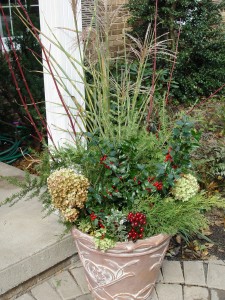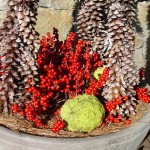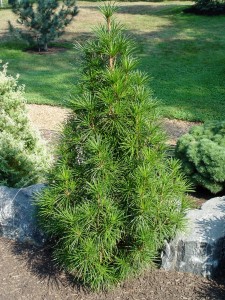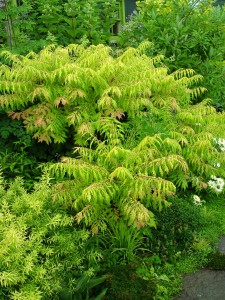Woody Plants in Pots
October 11th, 2011
You’re probably getting ready to pick a peck of petered-out petunias from your pots and pack the pots away for winter.
Did you think about converting at least of couple of them for winter interest?

A pot converted to a winter display featuring holly sprigs, dried hydrangeas, ornamental grass, juniper and red-twig dogwood stems.
The quick-and-easy way is to just take cuttings from around the yard and stick them into the soil in whatever bouquet-like arrangement you like.
Some of the best choices are sprigs of fruited hollies, junipers and viburnums; a few stems of red-twig dogwood and Japanese maple; maybe a branch or two of hipped-up rose branches, and cuttings from ornamental grasses, firs, falsecypress and spruce.
I’m also partial to a few osage oranges. Those are the warty, baseball-sized orbs that fall from wild osage orange trees and look a lot like green lemons.
But beyond that, most woody plants grow just fine in pots throughout the year.
You just need a big enough pot and a variety that’s winter-hardy enough to stay outside all year long. Otherwise, border-line-hardy and tender woody plants (Meyer lemons, camellias and crape myrtles, for example) need to be wheeled inside a sunroom or garage for winter.
The classic winter pot is a pair of upright needled evergreens flanking the front door. These are ideal for stringing with lights for the holidays.
Come spring, you can either plant them in the ground somewhere or move them to a deck or other strategic spot where you could use a little screening.
My Patriot-News garden column this Thursday (Oct. 13, 2011) will go into more detail about growing woody plants in pots. It’s also posted at https://georgeweigel.net/favorite-past-garden-columns/trees-in-pots.
If you’d like to take crack at growing a few woody plants in pots, here are 10 that I like as striking pot specimens:
1.) Cutleaf weeping Japanese maple. The leaves are lacy, and the habit is umbrella-like. Can be kept in the 6-foot range. Particularly nice are red-leafed ‘Tamukeyama,’ ‘Garnet’ and ‘Red Feather.’
2.) Purple smokebush.Rounded leaves of purple-burgundy on a multiple-stemmed mini-tree. Gets creamy-white flower “puffs” in late spring. However, these are best cut back to a stub at the end of each to maintain size and the best leaf color. That’ll sacrifice the flowers.
3.) Japanese umbrella pine. A pyramidal evergreen with unusual needles that look like fleshy light-green straws spraying out of the branches. Beautiful and slow-growing.
4.) Weeping Serbian spruce ‘Pendula Bruns.’ A little hard to find, but it’s a slow-growing, needled evergreen with a weeping habit and silvery blue needles.
5.) Dappled willow ‘Hakura Nishiki.’ A part-shade mini-tree with multiple stems and heavily variegated new growth that makes the wispy plant look like it’s almost white. Like smokebush, it’s best cut to a stub every March.
6.) Japanese plum yew ‘Fastigiata.’ A deer-resistant, dark-green, soft-needled evergreen that looks like a yew except the needles are bigger and flatter. This one grows into a skinny column. It almost has a tropical look to it.
7.) Elderberry ‘Black Lace.’ A large, fast-growing shrub that puts out heavily dissected leaves of nearly jet black. Gets pinkish-white flower clusters in late spring. Just snip as needed to keep it the size and shape you like.
8.) Tree-type hydrangea.Hydrangeas that grow upright to 6 or 8 feet and get cone-shaped flowers from mid-summer to early fall. ‘Limelight’ blooms pure white; ‘Vanilla Strawberry’ and ‘Pinky Winky’ are bicolor white and pink. Will grow as a single-stem “standard” or as a multi-stemmed shrub.
9.) Sumac ‘Tiger Eye.’ A 6-foot deer-resistant shrub with heavily dissected leaves of neon gold all season. A real eye-grabber that you’ll either love or hate.
10.) Tree peony. A woody type of peony that gets the same, large, rose-like spring flowers as the more familiar herbaceous peonies, only these don’t die back to the ground in winter. Growth habit is like a small, leaf-dropping tree.










